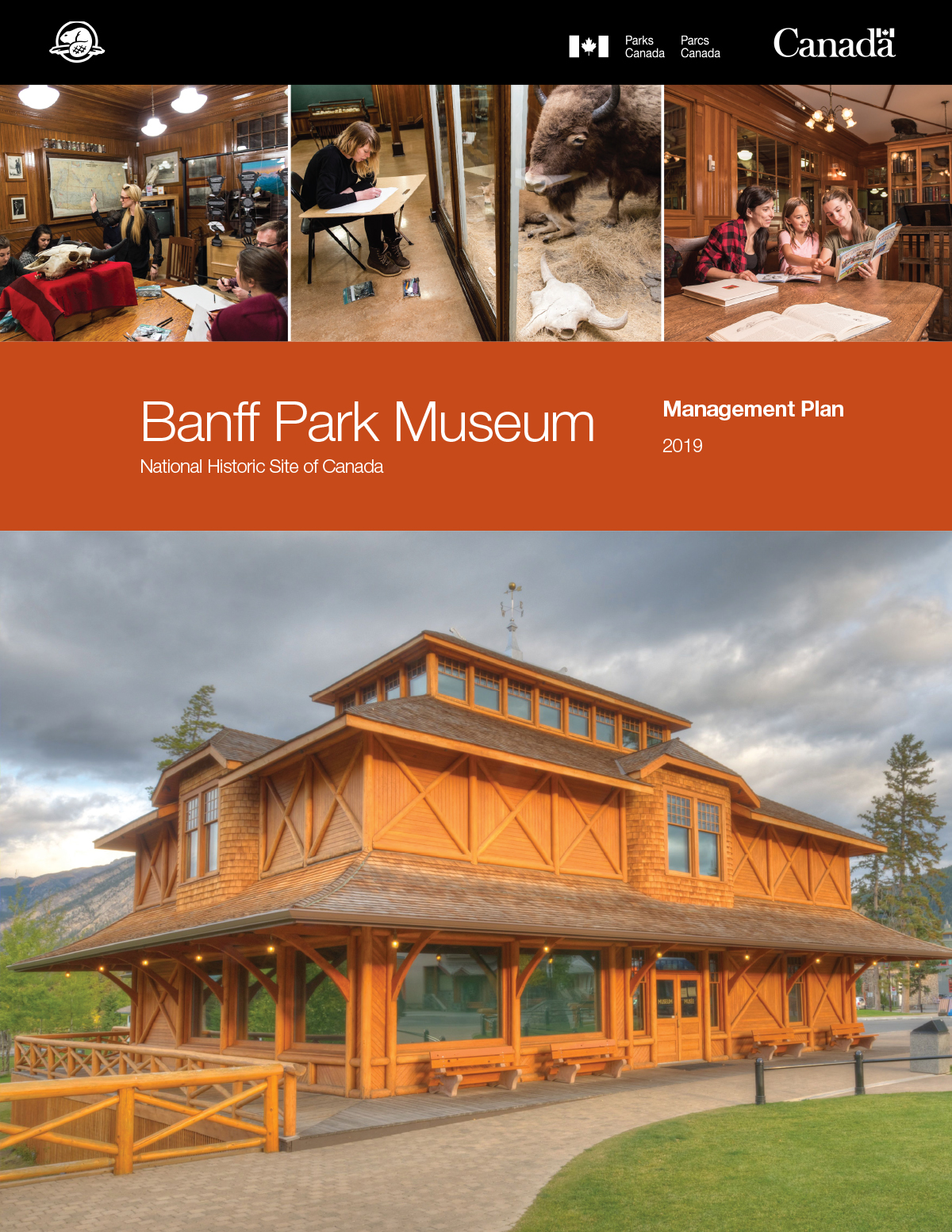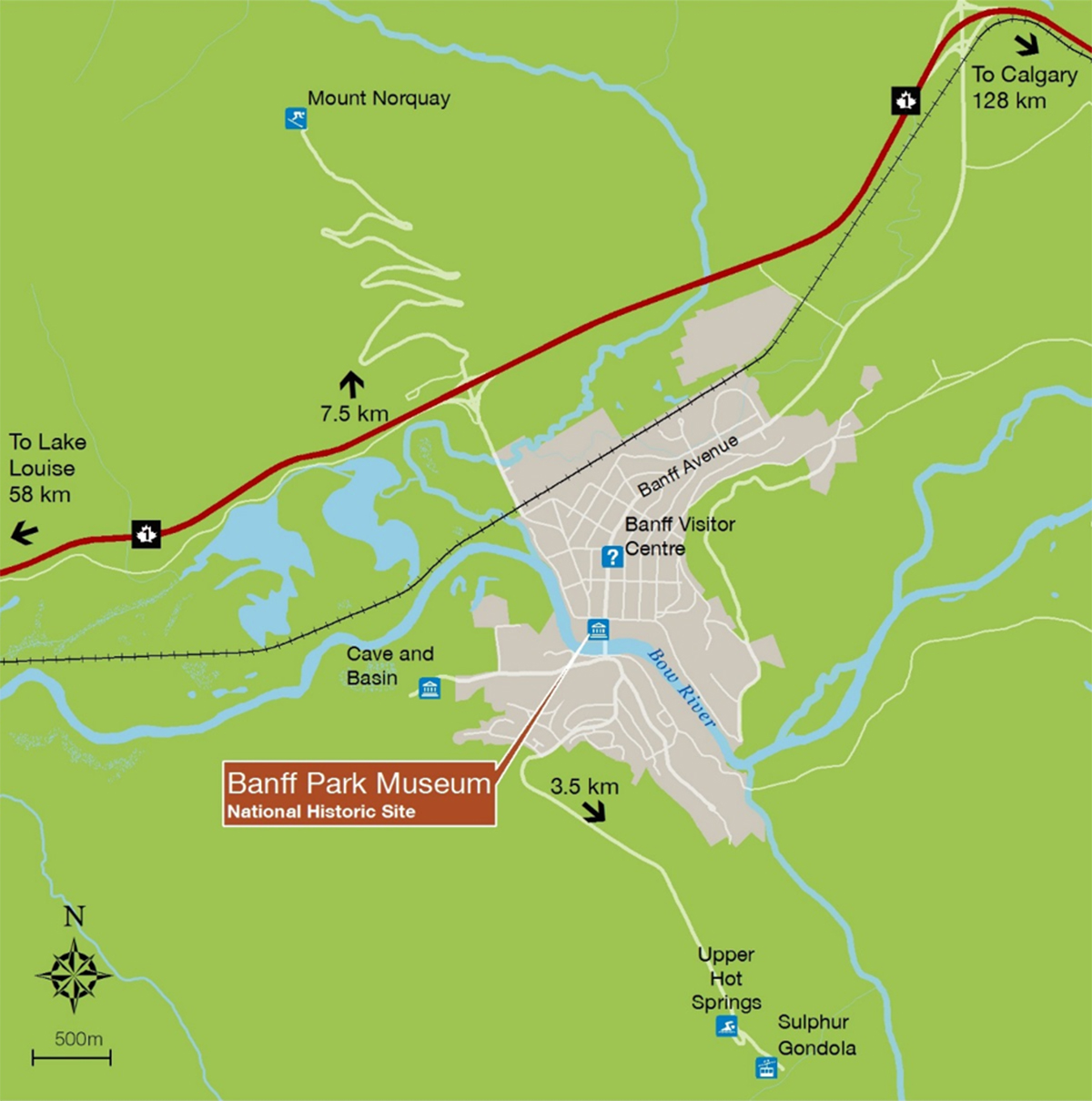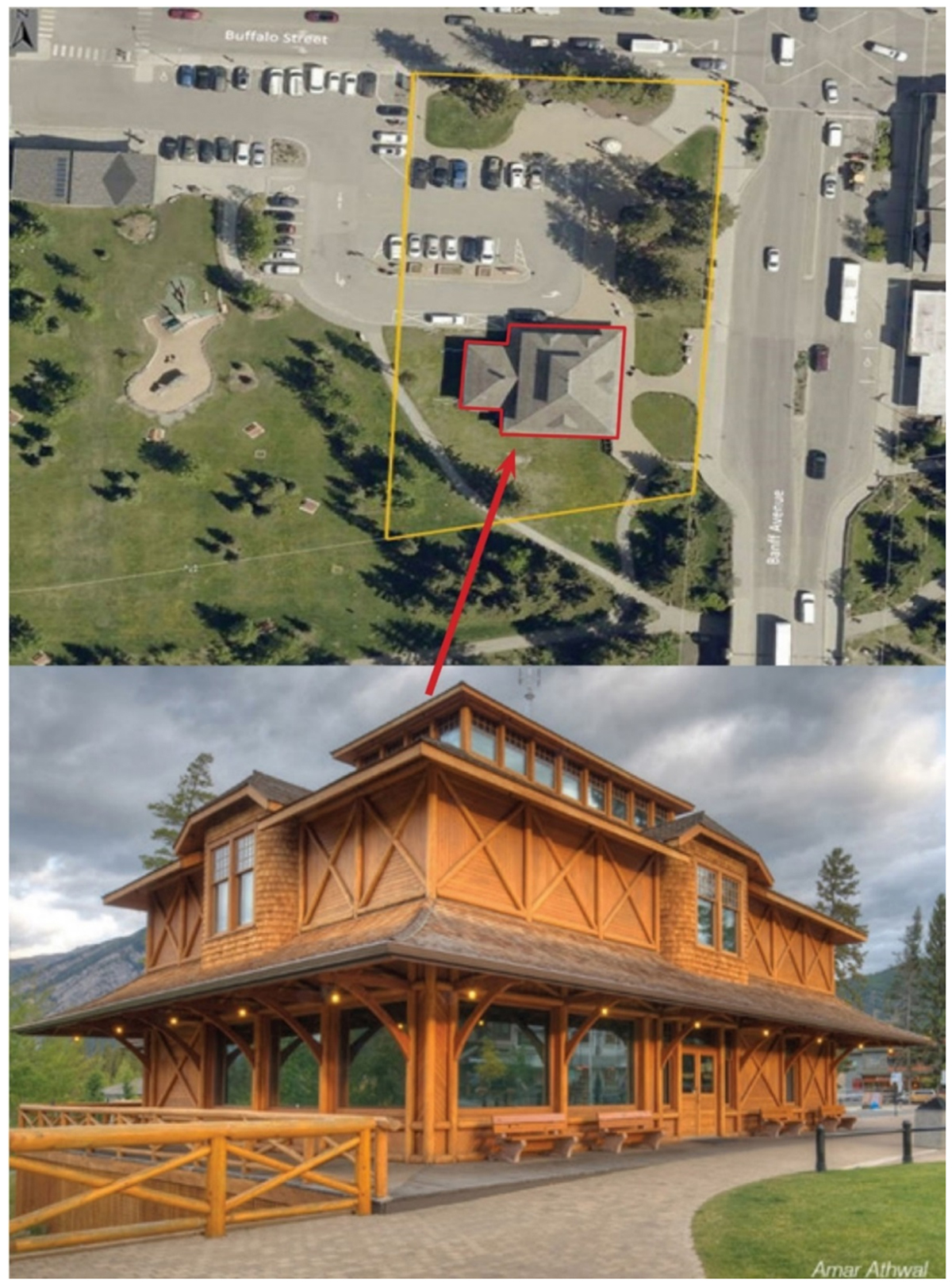Banff Park Museum National Historic Site of Canada Management Plan, 2019
Banff Park Museum National Historic Site
Table of Contents

© Her Majesty the Queen in Right of Canada, represented by the Chief Executive Officer of Parks Canada, 2019.
Cette publication est aussi disponible en français.
Banff Park Museum National Historic Site of Canada Management Plan, 2019.
- Paper: R64-105/98-2019E
- 978-0-660-31765-6
- PDF: R64-105/98-2019E
- 978-0-660-31763-2
For more information about the management plan or about Banff Park Museum National Historic Site of Canada:
Parks Canada Agency
Box 900
101 Mountain Ave, Banff, Alberta T1L 1K2
Front cover image credits
top from left to right: Rita Taylor, Rita Taylor, Scott Munn
bottom: Amar Athwal
Foreword

Parks Canada manages one of the finest and most extensive systems of protected natural and historic places in the world.
This vast network of national parks, historic sites, and marine conservation areas represents the very best that Canada has to offer and tells stories about who we are, including the history, cultures and contributions of Indigenous peoples.
Management plans are key accountability documents for the management of heritage places. They are developed through extensive consultation and articulate long-term visions, set strategic management directions and establish objectives for Parks Canada places.
This management plan represents Parks Canada’s continued commitment to protect and present Banff Park Museum National Historic Site for the benefit of present and future generations.
The input from many dedicated individuals and organizations, including Indigenous peoples, local and regional residents, visitors and stakeholders has been invaluable in helping shape this plan.
Parks Canada will report on the progress toward achieving the objectives for Banff Park Museum National Historic Site, and review this management plan every ten years, or sooner if required.
I would like to thank everyone involved in the development of this management plan for their contributions and their commitment to the future of this national treasure. I am pleased to approve the Banff Park Museum National Historic Site Management Plan.
Recommendations
Recommended by and original signed by
Ron Hallman
Chief Executive Officer
Parks Canada
Michael Nadler
Acting Senior Vice-President, Operations
Parks Canada
Dave McDonough
Field Unit Superintendent - Banff Field Unit
Parks Canada
Executive summary
Banff Park Museum National Historic Site is one of Western Canada's oldest natural history museums. The iconic 1903 building is the best surviving example of the rustic architectural design popularized in early national park buildings. The museum and its zoological collection, ethnographic objects, library and archival collection, photographs, historic artwork and original furnishings constitute a significant cultural attraction at a prominent location on Banff Avenue in the town of Banff, Alberta.
The last management plan for Banff Park Museum National Historic Site was approved in 2007. The plan set out a vision and strategic direction, along with strategies for three key subjects: heritage protection, education and visitor experience. Good progress has been made in implementing direction from that plan, especially the conservation of the building’s defining exterior architectural elements and the redevelopment of the surrounding landscape.
This new management plan will build upon the accomplishments of the previous plan especially in regard to improving the visitor experience. Spanning the next 10 years, this management plan will focus on three key strategies.
- Key Strategy 1: Continue efforts to conserve the building and expand awareness of the museum, its collections and historical records.
Wooden elements of the building require regular maintenance. The majority of the collections consist of thousands of natural history specimens, many of which are over 100 years old. The continuing inventory and conservation of these will remain a priority. Historical records about the Banff Park Museum are widely distributed. An inventory of these records is required for effective management and improved understanding of these items, and for the development of new, relevant programming for visitors.
- Key Strategy 2: Enrich the visitor experience by enhancing partnerships, providing more contextual information for the main historic gallery, and repurposing the Discovery Room and Reading Room for new programming and learning opportunities.
An important cultural attraction that has served as the “University of the Hills” in Banff National Park for over 100 years, Banff Park Museum National Historic Site has the potential to play a greater role in connecting visitors with traditional knowledge, as well as science and conservation activities of the past and present. The aim of this strategy is to enrich and improve the visitor experience, by employing three primary approaches: engaging partners in new programming opportunities; providing better contextual information to introduce the purpose of the museum and its main historic gallery; and repurposing the Discovery and Reading rooms as flexible spaces for contemporary exhibits and activities. Working with Indigenous peoples to reflect their stories and voices is a central part of this strategy.
- Key Strategy 3: Improve the sense of place and arrival to the site.
This strategy recognizes the longstanding connection between the museum and its surrounding lands, and the property's value as an outdoor programming space. It builds on the existing landscape elements and interpretive components that are outside the museum, in order to create a more appealing and informative introduction to the national historic site.
1.0 Introduction
Parks Canada manages one of the finest and most extensive systems of protected natural and historic places in the world. The Agency’s mandate is to protect and present these places for the benefit and enjoyment of current and future generations. Future-oriented, strategic management of each national park, national marine conservation area and heritage canal, as well as those national historic sites administered by Parks Canada supports the Agency’s vision:
Canada’s treasured natural and historic places will be a living legacy, connecting hearts and minds to a stronger, deeper understanding of the very essence of Canada.
The Parks Canada Agency Act requires Parks Canada to prepare a management plan for each national historic site administered by the Agency. The Banff Park Museum National Historic Site of Canada Management Plan, once approved by the Chief Executive Officer of Parks Canada, ensures Parks Canada’s accountability to Canadians, outlining how historic site management will achieve measurable results in support of the Agency’s mandate.
Canadians, including Indigenous peoples, were involved in the preparation of the management plan, helping to shape the future direction of the national historic site. The plan sets a clear, strategic direction for the management and operation of Banff Park Museum National Historic Site by articulating a vision, key strategies and objectives. Parks Canada will report annually on progress toward achieving the plan's objectives, and will review the plan every ten years or sooner if required. This plan is not an end in and of itself. Parks Canada will maintain an open dialogue on the implementation of the management plan, to ensure that it remains relevant and meaningful. The plan will serve as the focus for ongoing engagement on the management of Banff Park Museum National Historic Site in the years to come. This map shows the regional setting of the Banff Park Museum National Historic site, locations include: This image shows a satellite map location of the Banff Park Museum National Historic Site and a photo of the exterior of the Banff Park Museum National Historic Site. Yellow boundary indicates Parks Canada property. Red boundary indicates the national historic site. The Victorian era introduced an age of transformation in which momentous changes in the field of natural history coincided with the emergence of new visual displays and the public presentation of taxidermy collections. The Banff Park Museum, first proposed as an early attraction in the town of Banff in 1886, became one of a number of institutions established in Western Canada in the late nineteenth century to curate and display natural history collections from the region. The Banff Park Museum National Historic Site is an outstanding example of this late nineteenth- and early twentieth-century museological practice, offering present-day visitors an opportunity to see not only what was collected, but also the way it was displayed. Built in 1903 to house exhibit collections and the office of the Banff National Park superintendent, the Banff Park Museum National Historic Site is one of the best surviving examples of the rustic architectural design popularized in early national park buildings. In 1981, the Historic Sites and Monuments Board of Canada recommended that the Banff Park Museum be designated a national historic site. The commemorative intent of the museum is expressed in the following statement: “The Banff Park Museum is of national historic significance because this 'museum of museums' developed by Norman Bethune Sanson, reflects an early approach to the interpretation of natural history in Canada and because of the architectural style and detailing so characteristic of early federal building in Canada.” The national historic site designation applies to the 1903 museum building envelope and a significant portion of the original collections. From its opening in 1895, the Banff Park Museum National Historic Site has functioned in part as an interpretive centre historically known as the “University of the Hills”, providing an opportunity for visitors to see firsthand examples of much of the flora and fauna of Banff National Park and Western Canada. Visitors to the town of Banff are drawn to the museum as one of the main architectural landmarks on Banff Avenue. The rustic design of the building, coupled with its prominent location, attract walk-in visitors. The main historic gallery displays the original material collected and curated by Norman Bethune Sanson, including display cases and habitat dioramas. Two rooms adjacent to the main historic gallery were renovated in the 1980s and 1990s to provide additional spaces for public programming, and these contain limited original historic material. Upon their arrival, museum visitors are greeted at the entry by Parks Canada staff, who present messages about the history of the museum and its precious collections. As a whole, the museum enables visitors to experience an early approach to collection and interpretation of natural history specimens. The collections provide a unique opportunity for visitors to see real-life examples of the various animals that roam the park. The area designated as Banff Park Museum National Historic Site is confined to the footprint of the building. The museum sits on two parcels of land owned by Parks Canada (see Map 2). A key value of this site, identified in the Commemorative Integrity Statement, is its urban setting, marked by its relationship to the Bow River and Banff Avenue, its trees and pedestrian walkways, and the adjacent open spaces once occupied by the former zoo, a picnic pavilion and the 1910 Royal North West Mounted Police Barracks building. The Town of Banff's Central Park to the east, once the location of the museum’s zoo and botanical exhibits, is an open space that contributes to this sense of place in the broader national park context, along with a portion of the land owned by Parks Canada at the museum site. Directly beside the museum, another portion of the land belonging to Parks Canada is currently used by the Town of Banff as a public parking lot. While Banff Park Museum has operated as a public institution for more than a century and as a national historic site since 1985, there has been minimal investment in baseline historical research on its collections and the public presentation of its main themes and messages. Investment is needed to gather traditional knowledge and to conduct historical and curatorial research to inform the future management of the collections and enhancements to visitor programming. In 2017, the Commemorative Integrity Evaluation of this site identified 3503 objects of national historic significance in the museum collections (zoological, ethnographic and library items, photographs, artwork, and original furnishings). A review of the records for these collections indicates discrepancies between the list of objects of national historic value in the 2017 Commemorative Integrity Evaluation, and that in the formal Parks Canada Artifact Information System. An updated inventory of the museum collections is underway, and required for effective long-term management and protection. Over the years, the accommodation of the substantial number of records and objects stored at the site has continued to be an issue. Display cabinets in the main gallery house many objects in drawers and cabinets that are not accessible to the public. A large number of objects and records are stored in the basement. A thorough inventory and evaluation of all of these items is needed; this should be followed by decisions about whether or not they belong in the museum's collections or elsewhere such as Parks Canada’s National Archives, how they should be made accessible to the public, and what conditions are required for their long-term storage and conservation. The condition of the building's interior environment, and of the objects of national historic significance on display, is a growing concern. Work is required on the building's aging mechanical systems and on lighting options, in order to improve the interior environment for collections. The building is also adjacent to the Bow River. Although no recorded floods have reached the building, the potential for flooding during a major weather event is a concern. The aesthetic of the museum’s exterior and the interpretive information provided outside the building play a critical role in attracting visitors and establishing expectations for the inside of the national historic site. While exterior landscape work has helped to improve the sense of place and arrival, the building itself does not feel welcoming. All windows in the museum have been covered with dark, UV/light-reducing membranes as a conservation treatment to protect the collections. These membranes block the view from the outside to the inside of the building, creating an overall strong impression that the building is closed. In addition, because of the fragile nature of the collections, rigorous pest-management protocols are in place, which require that the entrance doors are never propped open. Although outdoor signs invite people into the building and explain its purpose, more work is required to improve the sense of welcome and orientation to the site. Visitors who enter the museum have an opportunity to experience the rustic architecture of the 1903 building more deeply, and also to view the taxidermy exhibits and habitat displays. Visitors can also associate the wildlife they see on display with the wildlife that they know are protected in Banff National Park. A new Visitor Experience Strategy would offer a strong opportunity to connect the Banff Park Museum National Historic Site with contemporary themes, and find fresh, new ways to link the past and the present. The site's commemorative intent message, which values its "museum of museums" as "an early approach to the interpretation of natural history," can be linked with current science and conservation work taking place in Banff National Park (natural and cultural), and with Indigenous knowledge. The site also has the potential to serve as a community hub for promoting dialogue about the natural and cultural history of Banff National Park, current achievements and challenges, and citizen advocacy in support of Canada’s protected places. New exhibits and programs are needed at the museum to enhance the visitor experience in order to encourage repeat visitation. Working with partners on new visitor experiences will change the use of some interior spaces such as the Reading and Discovery rooms, and create the potential for new exhibits and programming on the lands adjacent to the museum. Some collections would have to be relocated to accommodate these new uses in some spaces. Any changes to programming and exhibits would be designed and managed to respect the significance of the building, its collections and its commemorative integrity. The rustic architectural building style of the Banff Park Museum National Historic Site is an enduring and iconic landmark on Banff Avenue. As visitors approach the building, they are drawn inside by the informative outdoor exhibits and by the attractiveness of the front entrance and surrounding landscape. Once inside the building, visitors are delighted to find out that the Banff Park Museum National Historic Site is not only a window to the past, it is also a gateway through which they can connect to the contemporary science and research practices of Parks Canada and community partners, as well as Indigenous knowledge and perspectives. In the main gallery, visitors step back in time to experience an early approach to the interpretation of natural history. The exhibits and programs in the adjacent Reading Room and Discovery Room function as a bridge between the Victorian and Edwardian eras and the contemporary methods of science and conservation. This site provides an opportunity for all Canadians and international visitors to see the value of preserving the past, and how this preservation can inspire something that is new, bold and visionary. The management plan provides strategic direction for the delivery of Parks Canada’s mandate with regard to heritage resource protection, visitor experience and public appreciation and understanding. It proposes three main strategies. Key strategy 1: Continue efforts to conserve the building and expand awareness of the museum, its collections and historical records. This strategy ensures that the building and collections remain in good condition. Wooden elements of the exterior require regular maintenance. The majority of the collections consist of 100-year-old specimens that are delicate and sensitive to light and vibration. The Banff Park Museum off-site historical records are widely distributed at various locations. Objective 1.1: The museum’s structural condition, heritage character elements, collections and authentic setting are maintained in good condition. Targets: Objective 1.2: The interior environment of the museum is improved to safeguard the condition of collections. Targets: Objective 1.3: An inventory of the collections on display and in storage is complete, and collections are well understood. Target: Objective 1.4: The scope of historical records related to the Banff Park Museum is better understood. Targets: Key strategy 2: Enrich the visitor experience by enhancing partnerships, providing more contextual information for the main historic gallery, and repurposing the Discovery Room and Reading Room for new programming and learning opportunities. This strategy guides the revitalization of the visitor experience for many audiences through new research, the rehabilitation of exhibit spaces, new programming, and engagement with partners. Objective 2.1: An intersection of the contemporary interests of visitors to Banff National Park and the themes represented in the Banff Park Museum informs new programming and attracts new and repeat visitation. Targets: Objective 2.2: Enhance relationships with Indigenous groups to support reconciliation through collaborative initiatives and other opportunities which strengthen diversity and inclusion. Target: Targets will be developed through discussion with Indigenous groups. Objective 2.3: Parks Canada staff collaborate with partners to develop and deliver high-quality visitor experience programs and events. Targets: Objective 2.4: Visitors are inspired to explore connections between the past and the present. Target: Objective 2.5: Banff Park Museum National Historic Site is a treasured community gathering place and contributor to the cultural heritage of Banff National Park. Targets: Objective 2.6: Visitors are inspired by relevant and engaging experiences in an authentic historic setting. Targets: Key strategy 3: Improve the sense of place and arrival to the site. The museum sits on two parcels of land that are owned by Parks Canada. These lots are prominently located at the corner of Banff Avenue and Buffalo Street in the town of Banff, and are used primarily as public green space and a parking lot. The archaeological remains of the former location of the 1910 Royal North West Mounted Police Barracks building are located north of the museum on this land. Landscaped areas for interpretive signage and walkways to the national historic site are in prominent locations around the site. There has been a strong historical relationship between the museum and the lands that surround the building for more than 100 years. Objective 3.1: Manage development and use of the surrounding land in ways that support the commemorative integrity of the Banff Park Museum National Historic Site and that contribute to the visitor's sense of place and arrival. Targets: Parks Canada is responsible for assessing and mitigating the impacts of management actions on ecosystems and on cultural resources. The Cabinet Directive on the Environmental Assessment of Policy, Plan and Program Proposals prepared by the Impact Assessment Agency of Canada, requires a strategic environmental assessment (SEA) of all plans and policies submitted to the federal Cabinet or to a Minister for approval deemed to have important positive or negative environmental effects. A strategic environmental assessment was undertaken on this management plan, and the management direction found within has been adjusted to respond to findings. The following is a summary of the environmental assessment: The spatial scope of the SEA was limited to areas within the boundary of Banff Park Museum National Historic Site. The temporal scope was ten years from the date of the approval of the proposed management plan. The resources considered by the assessment to be valued components of the national historic site are primarily cultural resources, but also include visitor experience resources such as the ancillary visitor facilities and green space adjacent to the site. The management plan calls for the development of a Visitor Experience Strategy. This strategy will attempt to find opportunities for the contemporary interests of visitors to intersect with the historic themes of the national historic site. Actions such as the proposed repurposing of the Discovery Room and Reading Room by 2025 will require further assessment using the tools identified (e.g., a cultural resource impact assessment). It is anticipated that a project-level impact assessment can identify mitigations for any potential adverse impacts from individual projects that may result from this management plan. No important adverse environmental effects are anticipated from the implementation of this management plan, if the appropriate mitigation measures are applied. The overall environmental effects of the strategies, objectives and targets of this plan are expected to be positive.Map 1: Regional setting

Regional setting of Banff Park Museum National Historic Site - Text Version
Map 2: Banff Park Museum National Historic Site

Banff Park Museum National Historic Site - Text Version
2.0 Significance of Banff Park Museum National Historic Site
3.0 Planning context
Key issues and opportunities
Research and cultural resources
Interior and exterior risks
Sense of arrival and visitor experience
4.0 Vision
5.0 Key strategies
6.0 Summary of the Strategic Environmental Assessment
- Date modified :